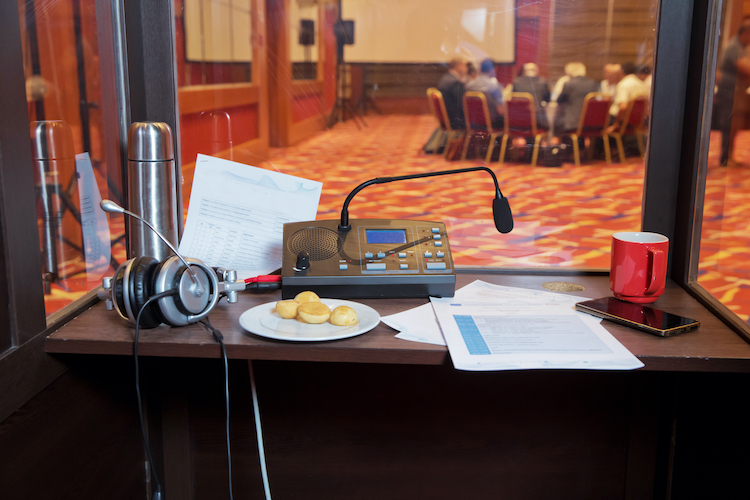
When work dried up
As a result of the Covid-19 outbreak, the world came to a standstill: businesses closed, events were cancelled and appointments postponed. And consequently, for many interpreters, the diary was wiped clean. Because what work is there to do if there are no court hearings, no conferences and no driving tests and weddings? For me as a translator/interpreter, as for many of my colleagues, the effect was instantaneous. The phone stayed silent. The tumbleweed in my inbox was almost audible.
I was fortunate enough to have enough translation work to keep me going, but even on that front it was distinctly slower than before, and the type of work also changed. Most of the texts I translated in the first few weeks (and months) of lockdown were internal notices for employees about Covid-19 prevention measures, new rules about working from home, how to install Zoom, the do’s and don’ts of online meetings etc. I am so glad I have a large enough number of direct corporate customers and agencies to work for instead of being 100% reliant on the public service work!
A technological learning curve
After a few weeks of empty diaries and with despair starting to set in (‘How long IS this going to last?’), interpreters basically had two options: either sit back and wait it out – and apply for the TOGS/TOZO or whatever other arrangements they were eligible for – or explore methods to continue working and embrace new technologies. Slowly but surely, the business world started to wake up again and discovered that you could conduct meetings online just fine. And that was our way in! Where it had been a bit of a niche market before, now suddenly remote simultaneous interpreting (RSI for short) was everywhere! Experienced interpreters are now also sharing their knowledge about RSI by giving webinars and facilitating online interpreting sessions, which is not only educational but also great fun.
The technology that had been available before is now being further developed at lightning speed: there are stand-alone interpreting platforms (eg, VoiceBoxer) or platforms that can be incorporated into meeting software such as Zoom (which has its own interpretation option too). This means that tech-savvy commercial interpreters have been able to get back on the horse. Many companies are also now realizing that it saves a lot of time – including travel time. And, if the technical requirements are met, they are seeing the benefits of having a meeting online where foreign participants can follow what is being said by tuning into their own language channel.
So far, so good!
Commercial versus PSI
On the public service interpreting (PSI) front, courts and government institutions have also been doing their best to incorporate RSI into their way of working. However, as with most public service institutions (… can I say it? ambtenaren…) it has taken a while to get it all up and running. Picture if you can a judge in one room and a clerk in another; plus a prosecutor, a lawyer, and a suspect or inmate in an echoey interrogation room (often with guards impatiently looking at their watches). Getting these people all talking to each other in a structured manner turns out to be quite a feat – not to mention the ‘complication’ of having an interpreter ‘sitting in the middle’. Interpreting these sessions is very frustrating as, more often than not, the video or phone connection is so terrible that interpreting is close to impossible. It also takes longer, as everything has to be done consecutively… And if you then also have a judge who asks the interpreter to ‘summarize your interpretation, because we are in a hurry’ or who denies a suspect their last word because their 20 or 40 minutes is nearly up, you can see why lots of interpreters and lawyers are quite unhappy with the situation.
Back to normal?
When physical sessions resumed a few weeks ago, we all had to get used to the ‘new normal’. How do you maintain physical distance while also making yourself heard and hearing what your client is saying? Is simultaneous interpreting even possible anymore? Every assignment throws up new surprises and challenges, as the set-up is different in every court and interview room. Sometimes half of the parties are physically present, while the rest are on a screen or on the phone – again complicating matters… Luckily, as interpreters, we are masters of improvisation, and most hearings have been able to continue, albeit with a bit of fudging here and there. Some courts have purchased mobile phones, so you can call the suspect sitting on the other side of the plexiglass and interpret the hearing that way. The courts are also still in the middle of the tendering process for whisper systems, so who knows what swanky gear we will be working with in the future!
The immediate future will undoubtedly remain messy, also because the situation for sworn interpreters and translators is not about to improve with the introduction of a new Dutch governmental decree on costs, quality and outsourcing, but I hope that as interpreters we will also continue to learn, to improve our technological expertise and also to educate our clients on how to incorporate new technology.